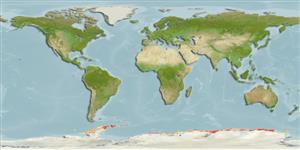>
Perciformes/Notothenioidei (Icefishes) >
Nototheniidae (Cod icefishes) > Trematominae
Etymology: Trematomus: Greek, trematos = hole + Greek, tomo = section, cut (Ref. 45335); tokarevi: Named after Dr. A.K. Tokarev, ichthyologist of the First Soviet Antarctic Expedition (Ref. 11892).
Eponymy: Dr Aleksey K Tokarev (1915–1957) served as ichthyologist on the First Soviet Antarctic Expedition. He died while returning from the Antarctic. (Ref. 128868), visit book page.
More on author: Andriashev.
Issue
The genus Pseudotrematomus is a synonym of Trematomus, which is confirmed by a molecular study to be published (J.-C. Hureau, pers. comm. 08 Jun. 2010).
Environment: milieu / climate zone / depth range / distribution range
Ökologie
seewasser bathydemersal; tiefenbereich 200 - 700 m (Ref. 122792). Deep-water; 60°S - 70°S
Southern Ocean: Oates Land and Shackleton Ice Shelf in East Antarctic, and near the South Orkney and South Shetland Islands.
Size / Gewicht / Alter
Maturity: Lm ? range ? - ? cm
Max length : 22.4 cm TL Männchen/unbestimmt; (Ref. 5179)
Rückenflossenstacheln (insgesamt) : 4 - 6; Rückenflossenweichstrahlen (insgesamt) : 35 - 37; Afterflossenweichstrahlen: 32 - 33; Wirbelzahl: 51 - 53. Slender, deep bodied form. Light cinnamon brown with greenish hue above, light below. Body with spots and strands of grayish-brown.
A deep-water species, generally inhabiting deep waters and less frequently in shallow waters. Collected from flat bottom without big shelters, like rocky niches and seaweeds (Ref. 122792).
Life cycle and mating behavior
Geschlechtsreife | Fortpflanzung | Ablaichen | Eier | Fecundity | Larven
Dewitt, H.H., P.C. Heemstra and O. Gon, 1990. Nototheniidae. p. 279-331. In O. Gon and P.C. Heemstra (eds.) Fishes of the Southern Ocean. J.L.B. Smith Institute of Ichthyology, Grahamstown, South Africa. (Ref. 5179)
IUCN Rote Liste Status (Ref. 130435: Version 2024-1)
Bedrohung für Menschen
Harmless
Nutzung durch Menschen
Fischereien: nicht kommerziell
Tools
Zusatzinformationen
Download XML
Internet Quellen
Estimates based on models
Preferred temperature (Ref.
123201): -1.4 - 0.8, mean -0.4 °C (based on 100 cells).
Phylogenetic diversity index (Ref.
82804): PD
50 = 0.5005 [Uniqueness, from 0.5 = low to 2.0 = high].
Bayesian length-weight: a=0.00537 (0.00279 - 0.01033), b=3.24 (3.08 - 3.40), in cm total length, based on LWR estimates for this Genus-body shape (Ref.
93245).
Trophic level (Ref.
69278): 3.2 ±0.41 se; based on food items.
Widerstandsfähigkeit (Ref.
120179): mittel, Verdopplung der Population dauert 1,4 - 4,4 Jahre. (Preliminary K or Fecundity.).
Fishing Vulnerability (Ref.
59153): Low vulnerability (12 of 100).
